IMEHA (International Model Equine Hobbyists Association) was an online photo showing site that existing until 2018. Included on the site were these guidebooks for judging and showing model horses in Performance classes. MEPSA has obtained permission to share the info contained in the guides.
Obstacles :: Point Deducts :: Tack :: Rider :: Reins :: Set-Up Options :: Photo Examples
A horse should demonstrate a willing walk and calmly work over and through all obstacles, showing agility, in control of the rider and on the bit, balance, and ready responsiveness. Horses that shy, pace, above the bridle or otherwise demonstrating excitement or lack of control are not suitable for arena trail. A trail horse should, however, not be a dead head but should show interest in the obstacles. A trail obstacle represents a test and the horse is judged on how well it is meeting that test. The obstacle may test calmness, agility or control. All obstacles test willingness and obedience. Credit will be given to horses negotiating the obstacles with style and some degree of speed, providing correctness is not sacrificed. Horses should receive credit for showing attentiveness to the obstacles and the capability of picking their own way through the course when obstacles warrant it, and willingly responding to the rider’s cues on more difficult obstacles. Gaits are halt, walk, jog, lope and back.
Western Trail requires that a horse must be negotiating an obstacle or have just finished working the obstacle but the obstacle must be clearly visible in the photo frame. No cross entering from Trail Trial or Natural Trail.
For additional helpful hints for Western Pleasure or other disciplines please check out Susan Hargrove’s site at: Oh Joy Farms.
Obstacles:
Many associations severely limit the obstacles allowed; especially AQHA, ApHA and APHC. However these restricted obstacles are allowed in USAE so unless the entry specifically states the horse is being shown in the restricted breed association approved show then a lenient standard should take precedence. Unless the obstacle is blatantly unsafe. USAE rules state unsafe obstacles are the following: fire extinguishers, perforated plywood in water boxes, exotic wild animals (lions, tigers and bears staked out) or unsafe elements such as hay bales (height too high and horse can stab and foot down into the bale and be unable to pull its foot free.) Note that these items should be banned, but not recommended. A setup with these items should not be eliminated but may be penalized at the judge’s discretion.
Recommended obstacles are as follows:
Approved Obstacles are:
Gate:
Opening, passing through and closing gate. (Losing control of gate is to be penalized.) Use a gate which will not endanger horse or rider. If the gate has a metal, plastic or wooden support bar under the opening, riders must work the gate moving forward through it. If gate has no support under it then horse and rider may back through the gate.
Ground Poles:
Ride over at least four logs or poles. These can be in a straight line, curved, zigzag or raised. The space between the logs is to be measured and the path the horse is to take should be the measuring point. All elevated elements must be placed in a cup, notched block, or otherwise secured so they cannot roll. The height should be measured from the ground to the top of the element. Care should be given to keep in mind the scale for the spacing of real walkovers, trotovers, and lopeovers which are:
(A) The spacing for walkovers shall be 20” to 24” (40 cm to 60 cm) and may be elevated to 12” (30 cm). Elevated walkovers should be set at least 22” (55 cm) apart.
(B) The spacing for trotovers shall be 3’ to 3’6” (90 cm-105 cm) and may be elevated to 8” (20 cm).
(C) The spacing for lopeovers shall be 6’ to 7’ (1.8 to 2.1 meters) or increments thereof, and may be elevated to 8” (20 cm).
Back Thru:
Backing obstacle. Backing obstacles to be spaced a minimum of 28” (70 cm). If elevated, 30” (75 cm) spacing is required. Entrants cannot be asked to back over a stationary object such as a wooden pole or metal bar.
(A) Back through and around at least three markers.
(B) Back through L, V, U, straight or similar-shaped course. May be elevated no more than 24” (60 cm).
Artificial Water Hazard:
Artificial Water Hazard of tarp as long as no metal or slick bottom-boxes are used.
Serpentine Obstacles
Serpentine obstacles at walk or jog. Spacing to be minimum of 6’ ( 1.8 meters) for jog.
Carry Objects:
Carry objects from one part of arena to another. Only objects which reasonably might be carried on a trail ride may be used.
Wooden Bridge:
Ride over wooden bridge. Suggested minimum width shall be 36” (90 cm) wide and at least six feet long. No railing may be used. Bridge should be sturdy, safe and negotiated at a walk only.
Slicker:
Slicker may be put on and removed.
Mail box:
Remove and replace materials from mailbox.
Side Pass:
Side pass. Side pass may be elevated to 12” (30 cm) maximum) as long as the ends are placed in a safe roll out or jump style knock down cup.
Square:
An obstacle consisting of four logs or rails, each 5’ to 7’ (1.5 to 2.1 meters) long, laid in a square. Each contestant will enter the square by riding over log or rail as designated. When all four feet are inside the square, rider should execute a turn, as indicated, and depart.
Combinations:
A combination of two or more of any obstacle listed above is acceptable.
IMEHA, APHC, AQHA & ApHC Prohibits the following Obstacles:
1. Tires
2. Animals
3. Hides
4. PVC Pipe
5. Dismounting
6. Jumps
7. Rocking, moving or railed bridges
8. Water box with floating or moving parts
9. Flames, dry ice, fire extinguishers, etc
10. Logs or poles elevated in a manner that permits such to roll
11. Ground ties
For additional helpful patterns of trail obstacles please check out this link: Trail Patterns
Extra Credit Should Be Given If:
(1) Split reins are used, the rein should fall on the same side as the rein hand.
(2) A romal rein is used; romal should fall on the opposite side from the rein hand (romal is usually held in the rider’s other hand).
(3) Entry Number is shown on saddle blanket or on rider’s back.
(4) Working the gate “tight”; opening the gate the minimum amount necessary to allow the horse and rider to pass while preventing imaginary stock from escaping.
(5) Any imagination in obstacle designed.
(6) Correct number of four poles showing in photo when ground poles are used or comment line noting the correct number of 4 ground poles.
Points Should Be Deducted If:
(1) Model penalized for any unnecessary delay while approaching or negotiating the obstacles.
(2) Models with artificial appearance over obstacles should be penalized.
(3) Model has front or hind feet in a single-strided slot or space at a walk or jog.
(4) Model skipping over or failing to step into required space.
(5) Model shows an incorrect number of strides, if specified.
(6) Model showing a blatant disobedience including shying, backing, kicking out, bucking, rearing, or striking.
(7) Model is on the wrong lead.
(8) Model exhibits excessive speed for gait assigned.
(9) Model appears to display a slowness in any gait or loss of forward momentum resulting in an animated and/or artificial gait at the lope.
(10) Model displays excessive nosing out.
(11) Model displays an opening mouth excessively.
(12) Model appears sullen, dull, lethargic, emaciated, drawn or overly tired.
(13) Model appears agitated has ears back, tail twirled, etc.
(14) Rider touches horse or saddle with free hand.
(15) Rider shown dropping slicker or object required to be carried on course.
(16) Model’s head is carried too high.
(17) Rider letting go of gate or dropping rope gate.
(18) Rider using either hand to instill fear or praise.
(19) Rider holding saddle with either hand.
(20) Rider shown touching the horse on the neck to lower the head.
(21) Rider uses spurs forward of the cinch.
(22) Rider has reins draped to the point that light contact is not maintained.
Required Tack:
A western stock saddle without tapaderos. The saddle can have either squared or rounded skirts with the current style leaning toward squared. In most breeds the current style also is to omit the rear cinch, sometimes adding “tabs” to occupy the rear girth slots; however, if a rear cinch is used, it must have a connecter strap to the front cinch. Breastplates are optional. Silver should not be counted over a good working outfit. A saddle pad resting under all pressure points is recommended but not required equipment. A western style bridle (browband, one ear, two ear, with or without throatlatch) with a curb bit including a curb strap or curb chain. Standard snaffle bit and bosal hackamores are permitted on horses 4 and under (5 and under for Arabians and Appaloosas). Romal reins and split reins are both legal; Romal reins are usually seen on Arabians, Morgans, and NSH. Missouri Fox Trotters usually wear a noseband and current style includes older buckstitched saddle. MFT current style saddle pads are white with white ribbon in mane and forelock.
Prohibited Tack:
Nosebands or cavessons (except: Missouri Fox Trotter and National Spotted Saddlebred/Walking Horse). any type of martingale or tiedown, tapaderos, roping reins, any kind of boots or bandages, crops or whips, mechanical hackamores are also prohibited. Split reins may not be knotted or attached to each other (stick wax is of course permitted in model horses) Rider may not have more than one finger between split reins or any fingers between the reins of a rein and romal.
Rider:
Attire is jeans, trousers or pants over western boots, long sleeved shirts, (vest, tie and jacket are also permitted) shotgun chaps, belt through loop, and western hat. The doll rider’s posture must be addressed because if you can’t get it correctly then don’t use it. Doll must sit down in the saddle, the back should be straight. There should be a straight vertical line between the rider’s ear, the elbow and the heel. The knee and toe of the boot should also be in a straight line, knees and feet turned straight along the side of the horse and heel of boot pointed down. The rein arm upper arm should be tucked into the side of the rider, elbow is bent and the forearm parallel to the ground. The free arm is held free and straight down with palm flat and lightly touching the leg. You may place ONE finger between your split reins and there is no rule as to which one – though most riders place their index finger between. If using romal reins the romal hand is carried with hand holding romal at the length of which the romal is straight and not curved. Hand then rest quietly near or on the doll’s leg. Hackamore or snaffle reins the riders hands should be carried near the pommel and not further than four inches (to scale) out on either side of the saddle horn. Rein hand wrist(s) of either rein is turned slightly inward. The doll rider’s head should be looking straight forward as if rider is looking through the horse’s ears.
Rein Hand Holds:
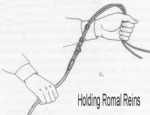

Rein Pull:
Horses are shown on a reasonable loose rein. Extremes such as too tight or too loose should be penalized.



Set-Up Options:
Arena Fencing Required (Indoor or Outdoor Arena)
Types of Fencing Allowed:
- Painted or Natural
- Post and Rail
- Post and Plank
- Chain Link
- Solid Plyboard
- Plyboard with Top Rail
- Post with Drape Rope
- Stock Tube Pipe Rail
- Interior Arena Wall
Footing Required:
- Dirt
- Sand
- No grass base
- No rock base
Backboard or Natural Setting (Indoor or Outdoor)
Examples of the Four Breed Divisions:
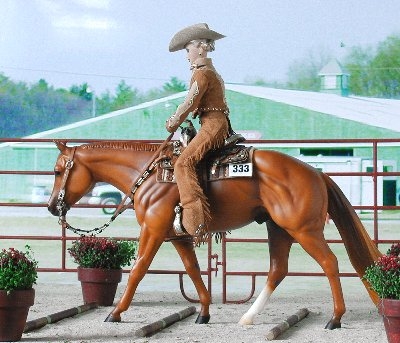
Western Trail Arena
Stock Breed Entry
Easy on the Attitude, showing has a Chestnut Quarter Horse Gelding is a Breyer Zippo Pine Bar. The entry is negotiating the jog over poles in the arena trail class. 4th pole hidden by flower pot. Note rider is using a correct hand hold on romal reins and horse as a correct head set on the bit while clearly negotiating the obstacle for a stock breed. Entry is owned by Andrea Robbins.
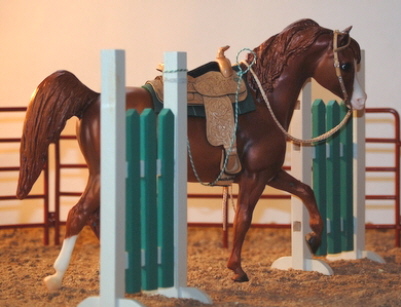
Western Trail Arena
Arabian Breed Entry
Masterhand shown by Lisa Smalley. Entry is very correctly shown working a rope gate obstacle. Entry as correctly set up the split reins and the gate rope loop so that when the horse walks through the gate and imaginary rider turn horse to replace loop over gate post the horse is correctly set up next to that post without the imaginary rider’s hand ever exchanging the hand hold of either the rope loop or the rein hand. Note higher flexion at the poll but horse is still on the bit. Meaning nose is not sticking straight outward but down on the bit.

Western Trail Arena
TB/WB or Sporthorse Breed Entry
Moonlight on Silk shown as a Dappled Gray Thoroughbred Gelding. He is a Stone TB Nazareth shown by Andrea Robbins. Entry is depicted as negotiating the trot-over poles using the correct head set and romal rein hand hold.
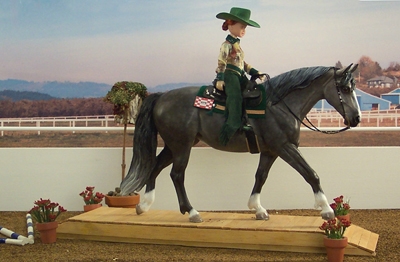
Western Trail Arena
Other Breed Entry
Ballyshannon shown as a dark grey Connemara mare is a Ballycore resin painted by Sherry Clayton. Note rider doll is a child doll. Horse and rider are shown walking calmly across bridge with added feature of a birdhouse that is equipped with a motion detector that emits bird song when passed. Note bridge is correct as it has no railing. Entry is owned by Robin Nere.
Hold the Reins Correctly:
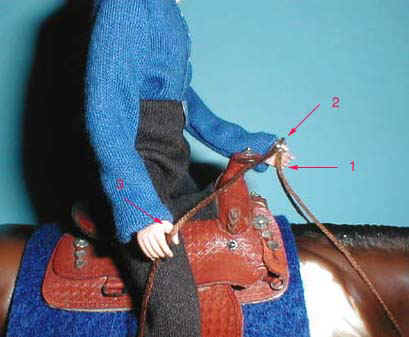
Romal Reins by Susan Hargrove
Romal reins enter the hand by the “little” finger lay across the palm of the hand and exit the hand on top over the thumb. The hand holds the reins and not the loop and knot that form the junction of the reins and the romal whip.
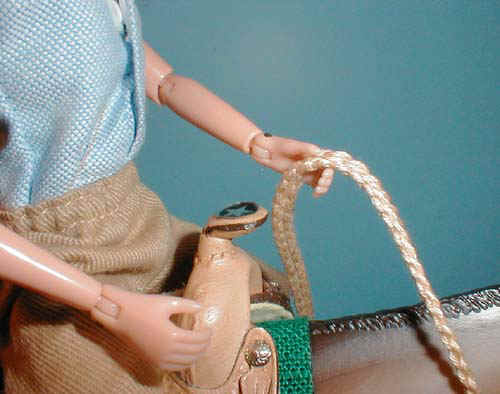
Split Reins by Susan Hargrove
Split reins can be held in the right or left hand. The excess rein hang over untouched on the same side of the horse. So if right hand hold the rein then the excess rein lies on the right side of the horse. If left hand holds the rein then the excess rein lies on the left side of the horse. Split reins enter the hand via coming straight into the hand over the index finger and they exit by the little finger.

Snaffle Reins by Susan Hargrove
The snaffle rein crosses over the horse’s neck with the bight extending down ward on the opposite side of the horse’s neck. Both hands are used on the reins by picking the rein and the bight up with the palms of the hands facing down.
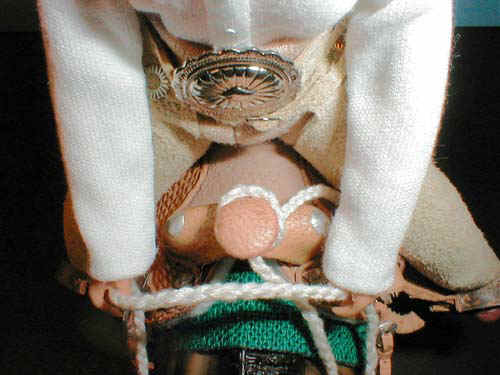
Hackamore Mecate Reins by Susan Hargrove
The hackamore mecate rein is a solid single loop rein with the bight tied from the bosal to either the saddle horn or coiled and tied to the front piggin string (or swell string) of the saddle. Both hands are used on the rein by picking the rein with the palms of the hands facing down.
